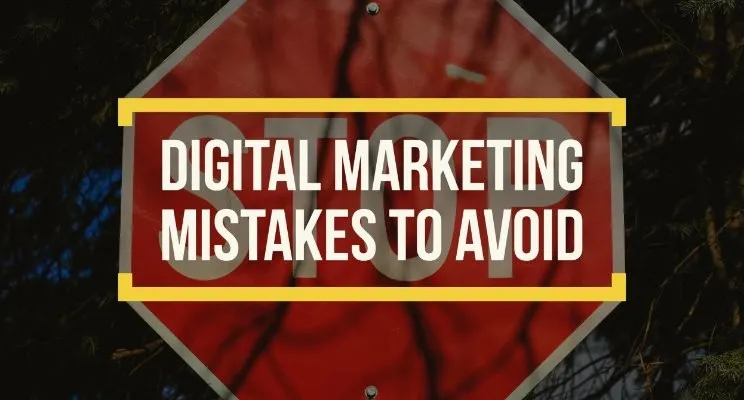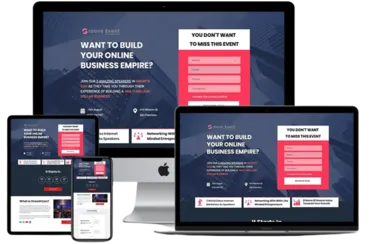7 Deadly Sins of Digital Marketing: Pitfalls You Must Avoid
Welcome to the ever-evolving realm of digital marketing, a landscape where strategies shift like tides, and success hinges on mastering the art of engagement. While the digital sphere offers boundless opportunities, it also comes with pitfalls that can hinder progress and tarnish efforts. Here, we'll explore seven pitfalls that marketers often encounter and should deftly sidestep.
Ignoring Data Insights
Ignoring Data Insights is akin to steering a ship without a compass in the vast sea of digital marketing. It's a common pitfall that can lead to missed opportunities, wasted resources, and lackluster results. Consider a scenario where a company launches a new product campaign without tracking key metrics like website traffic, user engagement, or conversion rates. Without these insights, they're essentially flying blind, unaware of whether their efforts are resonating with the target audience or falling flat.
Take, for instance, an e-commerce retailer that neglects to analyze customer purchase data and browsing behavior. Without understanding which products are selling well, which marketing channels are driving the most traffic, or which demographic segments are most responsive to their messaging, they risk making uninformed decisions that could impact their bottom line. However, by leveraging data insights, they could identify high-performing products, optimize marketing strategies to target specific audience segments, and allocate resources more effectively to drive sales and growth.
The solution lies in embracing data-driven decision-making and leveraging the wealth of information at our fingertips. By implementing robust analytics tools, setting clear objectives and KPIs, and regularly analyzing and iterating on campaign performance, marketers can unlock valuable insights that inform strategic decisions, drive optimization, and ultimately, propel their businesses forward in the digital landscape. Whether it's through platforms like Google Analytics, customer relationship management (CRM) systems, or integrated marketing platforms like GrooveFunnels, harnessing the power of data is essential for staying competitive and achieving success in today's digital age.
Overlooking Mobile Optimization
Overlooking Mobile Optimization is a grave oversight that can alienate a significant portion of a brand's audience. Consider a scenario where a retail company has a visually stunning website but fails to optimize it for mobile devices. As a result, mobile users experience slow loading times, distorted layouts, and frustrating navigation. This poor user experience can lead to high bounce rates and lost potential sales. Similarly, a restaurant that doesn't have a mobile-responsive website may deter customers who are searching for menus or making reservations on-the-go, ultimately impacting their bottom line.
The solution to this challenge lies in prioritizing mobile optimization across all digital touchpoints. Businesses can adopt responsive web design principles to ensure that their websites adapt seamlessly to various screen sizes and devices. Additionally, optimizing page load times, streamlining navigation, and implementing mobile-friendly features such as click-to-call buttons or location-based services can enhance the user experience for mobile users. For example, an e-commerce store like Amazon has mastered mobile optimization by providing a seamless shopping experience across devices, allowing users to browse, search, and purchase products effortlessly from their smartphones or tablets.
Furthermore, businesses can leverage mobile apps to complement their online presence and provide added convenience to users. For instance, a banking app that offers mobile check deposit or account management features empowers customers to handle their finances on-the-go. By investing in mobile optimization strategies, brands can not only improve user satisfaction but also stay competitive in a mobile-first world. Whether it's through responsive web design, mobile apps, or progressive web apps, prioritizing mobile optimization is essential for engaging and retaining today's increasingly mobile-savvy consumers.
Failing to Personalize Content
Failing to Personalize Content is a missed opportunity that can hinder a brand's ability to connect with its audience on a deeper level. Imagine receiving a generic email newsletter from a clothing retailer that showcases products irrelevant to your style preferences or past purchases. Without personalization, the content lacks relevance and fails to engage the recipient. Similarly, a travel website that doesn't tailor its recommendations based on a user's browsing history or location may miss the mark in providing relevant travel deals or destination suggestions. In today's digital age, consumers expect personalized experiences that resonate with their individual needs and interests.
The solution to this challenge lies in leveraging data-driven insights to deliver targeted and relevant content to your audience. By collecting and analyzing data such as browsing behavior, purchase history, and demographic information, businesses can segment their audience and tailor content accordingly. For example, an e-commerce platform like Amazon excels in personalization by recommending products based on a user's browsing and purchase history, enhancing the shopping experience and driving conversions. Similarly, streaming services like Netflix use algorithms to personalize content recommendations, ensuring that users are presented with movies and TV shows that match their viewing preferences.
Marketers can enhance content personalization by implementing dynamic content elements such as personalized product recommendations, customized email campaigns, and individualized website experiences. For instance, a fitness app could send personalized workout plans based on a user's fitness goals and exercise history, increasing engagement and retention. By prioritizing content personalization, businesses can foster stronger connections with their audience, drive customer loyalty, and ultimately, achieve better results in their marketing efforts.
Disregarding SEO Best Practices
Disregarding SEO Best Practices is a common pitfall that can severely impact a brand's online visibility and organic traffic. Consider a scenario where a company launches a new website without optimizing it for search engines. As a result, their website fails to rank prominently in search engine results pages (SERPs), making it difficult for potential customers to discover their products or services. Without adhering to SEO best practices such as keyword optimization, meta tag implementation, and quality content creation, businesses miss out on valuable opportunities to attract organic traffic and generate leads.
The solution to this challenge lies in implementing a comprehensive SEO strategy that encompasses both on-page and off-page optimization techniques. Businesses can conduct keyword research to identify relevant search terms that align with their target audience's intent and incorporate them strategically into website content, meta tags, and headers. Additionally, optimizing website structure and navigation, improving page load speed, and optimizing for mobile responsiveness are crucial aspects of on-page SEO that can enhance user experience and search engine rankings.
Businesses can boost their SEO efforts through off-page optimization tactics such as link building, social media engagement, and online directory listings. For example, securing high-quality backlinks from reputable websites signals authority and relevance to search engines, boosting a website's credibility and visibility in SERPs. Similarly, engaging with audiences on social media platforms and maintaining a consistent presence can drive referral traffic and enhance brand visibility. By prioritizing SEO best practices and staying abreast of algorithm updates, businesses can position themselves for long-term success and achieve sustainable growth in the digital landscape.
Overdoing Automation
"Overdoing Automation" is a pitfall that occurs when businesses rely too heavily on automated processes without considering the need for human touch and personalized interactions. Imagine receiving a series of generic, robotic-sounding emails from a company, lacking any personalization or relevance to your interests or previous interactions. In this scenario, the overuse of automation can lead to disengagement and alienation among recipients, ultimately diminishing the effectiveness of email marketing efforts. Similarly, social media posts scheduled at rigid intervals with no real-time engagement or interaction may come across as impersonal and detached, failing to foster meaningful connections with followers.
The solution to this challenge lies in striking the right balance between automation and humanization in marketing efforts. While automation can streamline repetitive tasks and increase efficiency, it's essential to incorporate elements of personalization and human touch to maintain authenticity and engagement. For example, businesses can utilize automation tools to send targeted email campaigns based on user behavior and preferences, while also incorporating personalized greetings, dynamic content, and interactive elements to create a more personalized experience for recipients.
Enhance the effectiveness of automation by leveraging real-time data and feedback to adapt and refine their strategies. For instance, monitoring engagement metrics such as open rates, click-through rates, and social media interactions allows marketers to gauge the effectiveness of automated campaigns and make adjustments as needed. Additionally, incorporating human oversight and intervention when necessary ensures that automated processes are aligned with brand values and customer expectations. By finding the right balance between automation and humanization, businesses can maximize the efficiency of their marketing efforts while maintaining meaningful connections with their audience.
Ignoring Social Media Engagement
Ignoring Social Media Engagement is a significant oversight that can hinder a brand's ability to connect with its audience and build meaningful relationships. Consider a scenario where a company maintains a presence on social media platforms but fails to actively engage with its followers. This lack of interaction can result in missed opportunities to address customer inquiries, respond to feedback, and cultivate a sense of community around the brand. Without fostering engagement on social media, businesses risk appearing distant and unapproachable, which can ultimately lead to a decline in brand loyalty and advocacy.
The solution to this challenge lies in prioritizing active engagement and interaction on social media platforms. Businesses can leverage social media as a two-way communication channel to connect with their audience, listen to their concerns, and provide timely responses. For example, responding promptly to customer inquiries, acknowledging feedback, and engaging in conversations demonstrates authenticity and a commitment to customer satisfaction. Additionally, businesses can encourage user-generated content, such as customer reviews, testimonials, and user-generated posts, which not only fosters community engagement but also serves as valuable social proof for the brand.
Enhance social media engagement by creating compelling and shareable content that resonates with their audience. By understanding their target demographic and tailoring content to their interests, preferences, and pain points, businesses can increase engagement and drive meaningful interactions. Additionally, leveraging features such as polls, quizzes, live videos, and interactive stories can encourage participation and foster a sense of connection with followers. By actively engaging with their audience on social media, businesses can strengthen brand loyalty, drive customer engagement, and ultimately, achieve greater success in the digital landscape.
Failing to Adapt to Trends
Failing to Adapt to Trends is a common pitfall that can leave businesses stagnant in a rapidly evolving digital landscape. Consider a scenario where a company continues to rely on outdated marketing tactics and channels, ignoring emerging trends and consumer preferences. This reluctance to adapt can result in missed opportunities to reach new audiences, connect with customers on emerging platforms, and capitalize on evolving consumer behaviors. For example, a retail brand that fails to embrace e-commerce and digital storefronts may struggle to compete with online competitors and meet the changing demands of modern shoppers.
The solution to this challenge lies in staying agile and responsive to emerging trends and technologies. Businesses must prioritize ongoing market research and trend analysis to identify shifts in consumer behavior, emerging platforms, and industry innovations. By keeping a finger on the pulse of the market, businesses can proactively adapt their strategies to stay ahead of the curve and capitalize on new opportunities. For example, a restaurant that embraces food delivery apps and contactless ordering systems can cater to changing consumer preferences for convenience and safety, ensuring continued relevance and competitiveness in the market.
Furthermore, businesses can foster a culture of innovation and experimentation to encourage adaptation to trends. By empowering employees to explore new ideas, test new technologies, and iterate on existing strategies, businesses can foster a culture of adaptability and innovation. Additionally, fostering collaboration and partnerships with industry leaders, influencers, and technology providers can provide valuable insights and resources to stay abreast of emerging trends and developments. By embracing change and continuously evolving their strategies, businesses can position themselves for long-term success and relevance in an ever-changing digital landscape.
There's A Change Ahead
GrooveFunnels Your Trusted All-in-One Solution
Are you ready to take your digital marketing game to the next level? Look no further than GrooveFunnels – the ultimate all-in-one platform designed to empower both beginners and seasoned marketers alike. GrooveFunnels is the ultimate solution to tackle the seven critical mistakes killing your conversions. Whether you're just starting out with a free account or looking to upgrade to advanced features, GrooveFunnels has everything you need to succeed.
- Build High-Converting Funnels: Use intuitive drag-and-drop builders to create sales funnels tailored to your business goals and audience.
- Track Performance: Analyze key metrics and track the performance of your funnels with built-in analytics tools, allowing you to make data-driven decisions and optimizations.
- Automate Marketing Processes: Utilize marketing automation features to set up automated email sequences, segment your audience, and deliver personalized messages at scale.
- Test and Optimize: Conduct A/B tests, analyze results, and make iterative changes to your funnels with ease, ensuring continuous improvement and maximum effectiveness.
- Cost-Effective Solution: GrooveFunnels all-in-one approach provides a cost-effective alternative to purchasing individual marketing tools from multiple vendors. GrooveFunnels also offers a free plan with limited features, making it an attractive option for startups and small businesses looking to kickstart their digital marketing efforts without upfront costs.
Get started for free and unlock basic features. Ready to level up? Upgrade for advanced analytics, split testing, and more. Supercharge your digital marketing and scale your business with GrooveFunnels today!
Do yourself a favor and sign up for your free Groove account right now.


























